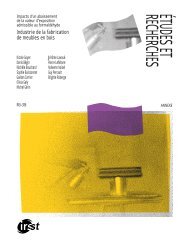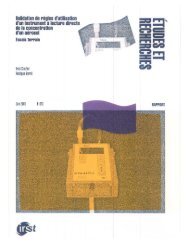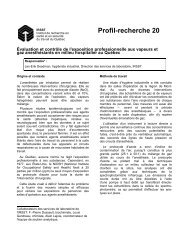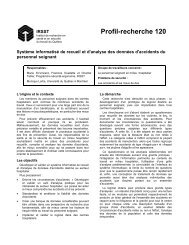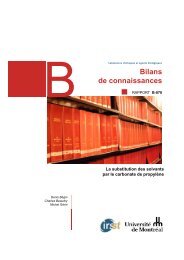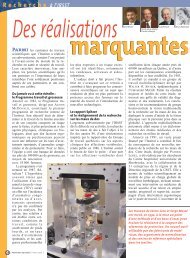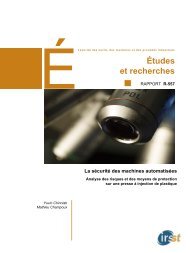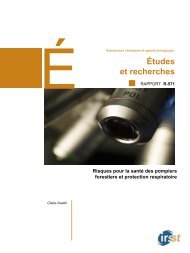Sampling Guide for Air Contaminants in the Workplace - Irsst
Sampling Guide for Air Contaminants in the Workplace - Irsst
Sampling Guide for Air Contaminants in the Workplace - Irsst
Create successful ePaper yourself
Turn your PDF publications into a flip-book with our unique Google optimized e-Paper software.
IRSST – <strong>Sampl<strong>in</strong>g</strong> <strong>Guide</strong> <strong>for</strong> <strong>Air</strong> <strong>Contam<strong>in</strong>ants</strong> <strong>in</strong> <strong>the</strong> <strong>Workplace</strong> 17<br />
Part 2: <strong>Sampl<strong>in</strong>g</strong> equipment and techniques<br />
Introduction<br />
Once <strong>the</strong> measurement strategy <strong>for</strong> <strong>the</strong> chemical substances or biological agents <strong>in</strong> <strong>the</strong> workplace has been<br />
chosen, measur<strong>in</strong>g equipment, techniques and methods <strong>for</strong> meet<strong>in</strong>g <strong>the</strong> objective must be selected.<br />
Measurements can be direct, us<strong>in</strong>g portable <strong>in</strong>struments, or <strong>in</strong>direct, by sampl<strong>in</strong>g on a collect<strong>in</strong>g medium and<br />
subsequent laboratory analysis. These direct or <strong>in</strong>direct techniques are described briefly <strong>in</strong> relation to <strong>the</strong> type<br />
of contam<strong>in</strong>ant: gases and vapours, aerosols (liquids, dusts and fumes), and microorganisms. The list of<br />
equipment required <strong>for</strong> sampl<strong>in</strong>g or analysis is presented <strong>in</strong> Part 3. O<strong>the</strong>r sections complete this part of <strong>the</strong><br />
guide by provid<strong>in</strong>g <strong>in</strong><strong>for</strong>mation about process samples and sampl<strong>in</strong>g us<strong>in</strong>g pumps.<br />
2.1 Concentration units <strong>for</strong> PEVs <strong>in</strong> <strong>the</strong> ROHS (ppm and mg/m³)<br />
The objective <strong>in</strong> us<strong>in</strong>g sampl<strong>in</strong>g equipment and techniques is to compare <strong>the</strong> concentration measurement<br />
results <strong>for</strong> an air contam<strong>in</strong>ant to a reference value, ma<strong>in</strong>ly <strong>the</strong> PEVs <strong>in</strong> <strong>the</strong> ROHS. It is <strong>the</strong>re<strong>for</strong>e important<br />
that <strong>the</strong> result of a measurement, whe<strong>the</strong>r expressed <strong>in</strong> ppm, mg/m 3 or <strong>in</strong> fibre/cm 3 , be comparable to <strong>the</strong><br />
value of <strong>the</strong> PEV <strong>in</strong> <strong>the</strong> ROHS and be consistent with <strong>the</strong> def<strong>in</strong>ition of <strong>the</strong> units. For this, <strong>the</strong> def<strong>in</strong>itions <strong>in</strong> <strong>the</strong><br />
Def<strong>in</strong>itions and Notes section of Schedule I of <strong>the</strong> ROHS are:<br />
"mg/m³: milligram per cubic meter (milligram of substance per cubic meter of air)<br />
ppm: parts per million (parts of gas or vapour per million parts of airborne contam<strong>in</strong>ants per volume<br />
measured at 25°C and 101.3 kPa)."<br />
Consequently, one must conclude that <strong>the</strong> PEV values expressed <strong>in</strong> ppm are established <strong>for</strong> specific conditions<br />
of temperature and pressure while <strong>the</strong> PEV values when expressed <strong>in</strong> mg/m³ or <strong>in</strong> fibres/cm³ <strong>in</strong> <strong>the</strong> ROHS are<br />
<strong>in</strong>variable <strong>in</strong> relation to environmental conditions. This reason<strong>in</strong>g is based on two premises described <strong>in</strong><br />
greater detail by Stephenson et al. (9), and by <strong>the</strong> ACGIH ® <strong>in</strong> 2012 (10):<br />
• The volume of air brea<strong>the</strong>d <strong>in</strong> by a worker dur<strong>in</strong>g his work day is not significantly different <strong>in</strong> relation<br />
to moderate variations <strong>in</strong> <strong>the</strong> ambient conditions of temperature and pressure;<br />
• Absorption of a gas or vapour is related to <strong>the</strong> partial pressure of <strong>the</strong> substance <strong>in</strong>volved (11).<br />
This approach is also used by o<strong>the</strong>r organizations propos<strong>in</strong>g reference values, such as OSHA's Permissible<br />
Exposure Limits (PELs) (12), <strong>the</strong> ACGIH's ® Threshold Limit Values (TLVs ® ) (10), and NIOSH's<br />
Recommended Exposure Limits (RELs) (13). The aim of this approach is to limit <strong>the</strong> quantity of contam<strong>in</strong>ant<br />
that can be <strong>in</strong>haled by a worker, and is <strong>the</strong>re<strong>for</strong>e similar to a permissible dose approach. It is important to<br />
emphasize that some countries such as Belgium (14) and Australia (15) have PEVs based on a permissible<br />
concentration approach. The reader must <strong>the</strong>re<strong>for</strong>e be careful when compar<strong>in</strong>g <strong>the</strong> literature from different<br />
countries because <strong>the</strong> manner <strong>in</strong> which compliance with a standard is verified may be different and lead to<br />
different conclusions.<br />
To expose a worker, <strong>in</strong>hal<strong>in</strong>g a certa<strong>in</strong> volume of air <strong>for</strong> a certa<strong>in</strong> period of time at a given dose and under<br />
different conditions, <strong>the</strong> PEVs <strong>in</strong> ppm must be adjusted <strong>in</strong> relation to <strong>the</strong> molar volume under <strong>the</strong> conditions<br />
of <strong>the</strong> site where <strong>the</strong> worker is located, or as a corollary, <strong>the</strong> concentrations <strong>in</strong> ppm <strong>for</strong> conditions o<strong>the</strong>r than<br />
NTP (normal temperature and pressure) must be corrected to "ppm at NTP" units be<strong>for</strong>e compar<strong>in</strong>g <strong>the</strong>m to<br />
<strong>the</strong> PEV expressed <strong>in</strong> ppm.<br />
In Québec, <strong>for</strong> <strong>the</strong> very great majority of workplaces, <strong>the</strong> molar fraction that compares <strong>the</strong> molar volume<br />
under certa<strong>in</strong> conditions to <strong>the</strong> molar volume at NTP (24.45 L) is close to unity. In this case, <strong>the</strong> permitted<br />
ppm concentrations will be practically equivalent to those at NTP. However, <strong>for</strong> extreme and ra<strong>the</strong>r rare<br />
conditions (<strong>for</strong> example <strong>for</strong> depth work <strong>in</strong> m<strong>in</strong>es), <strong>the</strong> molar fraction can differ significantly from unity.<br />
The follow<strong>in</strong>g guidel<strong>in</strong>es must be applied to verify compliance with PEVs:



